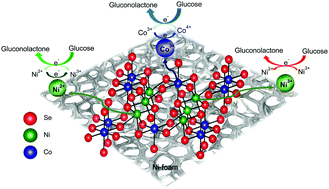A non-enzymatic glucose sensor based on a CoNi2Se4/rGO nanocomposite with ultrahigh sensitivity at low working potential†
Abstract
Uniform and porous CoNi2Se4 was successfully synthesized by electrodeposition onto a composite electrode comprising reduced graphene oxide (rGO) anchored on a Ni foam substrate (prepared hydrothermally). This CoNi2Se4–rGO@NF composite electrode has been employed as an electrocatalyst for the direct oxidation of glucose, thereby acting as a high-performance non-enzymatic glucose sensor. Direct electrochemical measurement with the as-prepared electrode in 0.1 M NaOH revealed that the CoNi2Se4–rGO nanocomposite has excellent electrocatalytic activity towards glucose oxidation in an alkaline medium with a sensitivity of 18.89 mA mM−1 cm−2 and a wide linear response from 1 μM to 4.0 mM at a low applied potential of +0.35 V vs. Ag|AgCl. This study also highlights the effect of decreasing the anion electronegativity on enhancing the electrocatalytic efficiency by lowering the potential needed for glucose oxidation. The catalyst composite also exhibits high selectivity towards glucose oxidation in the presence of several interferents normally found in physiological blood samples. A low glucose detection limit of 0.65 μM and long-term stability along with a short response time of approximately 4 seconds highlights the promising performance of the CoNi2Se4–rGO@NF electrode for non-enzymatic glucose sensing with high precision and reliability.



 Please wait while we load your content...
Please wait while we load your content...
